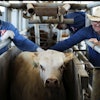
WASHINGTON (AP) — Businesses should close break rooms. Restaurants should consider disposable menus and plates. Schools should have students eat lunch in their classrooms.
These are some of the recommendations offered in new federal plans designed to help restaurants, schools, churches and businesses safely reopen as states look to gradually lift their coronavirus restrictions.
The draft guidance from the Centers for Disease Control and Prevention has been sent to Washington but still could be revised before the Trump administration unveils it to the public. The recommendations were obtained from a federal official who was not authorized to release them publicly.
The CDC put together so-called “decision trees” for at least seven types of organizations: schools, camps, childcare centers, religious facilities, mass transit systems, workplaces, and bars/restaurants.
White House officials previously released a three-phase reopening plan for the nation that mentioned schools and other organizations that come back online at different points. But it hadn't previously offered more specific how-to guidelines for each kind of entity.
The new guidance still amounts to little more than advice. State and local officials will be the ones to adopt and enforce them. Some state and local governments have already put rules in place for businesses that are operating. For example, Michigan requires businesses to limit how many customers can be in a store at one time.
New York Gov. Andrew Cuomo on Sunday said that each business that wants to reopen will have to submit a plan to the state on how to do that.
The new guidance could give state officials cover if their requirements for businesses are challenged in the courts, said Lindsay Wiley, an American University public health law expert.
“It allows the state to say ‘well the CDC said to do it this way,’ and the judge then is very happy to say 'well yes you consulted CDC and that’s the appropriate body,' and then uphold the restrictions and say they're appropriately evidence based."
Some examples from the guidance:
—In the initial reopening phases, schools should space desks six feet apart, nix any field trips and school assemblies, and have students eat lunch in their classrooms instead of the cafeteria.
—Churches should hold services through video streaming or at drive-in or outdoor venues as much as possible. They should also encourage everyone to wear cloth face masks, use a stationary collection box, and schedule extra services if necessary to make sure church pews are not packed and congregants stay at least six feet from each other.
—Restaurants should consider using throwaway menus, single-service condiments, and disposable forks, knives, spoons, and dishes. They should install sneeze guards at cash registers, limit the number of employees on a shift, and avoid having buffets, salad bars, and drink stations.
The guidance for religious groups includes providing congregants spiritual and emotional care “on a flexible or virtual basis or refer them to other available resources.”
Allen Fagin, executive vice president of the Orthodox Union, said that as much as worship in synagogues is “one of the most fundamental aspects of Jewish life,” his faith also believes that “the sanctity of life is more important than any other aspect of observance.”
Application of any guidelines are likely to have significant regional and demographic variation, Fagin added. “There’s going to have to be a great deal of both training and soul-searching in particular communities to make certain the guidelines are understood and will in fact be adhered to, to the letter,” he said.
Various trade groups have also started coming out with their own recommendations. For example, the National Restaurant Association last week put out guidance to restaurants considering reopening. The association said restaurants should clean and sanitize reusable menus, while the CDC suggests using disposable menus. And the CDC recommends that employees use cloth masks when interacting with customers, but the association doesn’t. But some guidance is similar. The association and the CDC both recommend seating dining parties at least 6 feet apart.
Larry Lynch, a senior vice president at the trade group, said the restaurant industry is already heavily regulated in order to prevent foodborne illnesses. So he doesn’t think additional guidelines from the CDC are onerous.
“The fact is we’re probably already 80% of the way there with the mandates coming out of the food code,” he said.
Lynch said the biggest concern for restaurant owners isn’t federal guidelines, but convincing people that it’s safe to return to restaurants.
Many companies, especially those with strong remote work capabilities, are already drawing up plans that go beyond the CDC's guidelines, said Bhushan Sethi, global people and organization leader at PwC, a consulting firm. He said many companies are considering keeping their employees working from home well after authorities lift stay-at-home orders.
“It’s a bare minimum compared to the playbook that many firms are putting in place,” Sethi said of the CDC guidelines on workplaces. “Firms are acknowledging that people are going to be fearful.”
About 65% of companies recently surveyed by PwC are planning to reconfigure work sites to allow physical distancing. Some 52% are planning staggered shifts or alternating crews, according to the April 18-22 survey of chief financial officers at 305 U.S. companies.






















